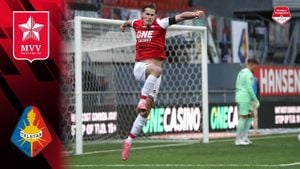This week, Valladolid has been buzzing with significant news events, mainly centered around the presentation of a new train station, cultural festivities, and local political changes.
The highly anticipated project, unveiled by Minister Óscar Puente, aims to transform Valladolid’s urban fabric with a new railway terminal boasting an investment of 253 million euros. Puente detailed plans for the station, emphasizing its design as not merely functional but also environmentally sustainable, incorporating new public spaces for pedestrians and cyclists. This ambitious project is expected to position Valladolid as a pivotal railway hub, maintaining the station's role at the city's center.
The initiative has sparked mixed reactions among local officials and citizens. Jesús Julio Carnero, representative of the local government, welcomed the investment, stating, “Cualquier inversión en Valladolid es bienvenida.” While he acknowledged the project's potential, he expressed reservations about its ability to address existing connectivity issues, indicating it might lead to increased physical obstructions rather than solutions. Carnero's concerns highlight apprehensions within the community about how the station improvements may affect local mobility.
Meanwhile, other local events have helped place Valladolid on the cultural map. The Semana Santa (Holy Week) festivities were propped up via a proclamation held this week, with José Vicente de los Mozos leading the ceremonies. Carnero praised these events, noting, “La Semana Santa de la ciudad de Valladolid emociona por su paisaje urbano, cultural y artístico histórico que relaciona el pasado con el presente y futuro, un patrimonio vivo para descubrir y disfrutar.” This connection to the city's historical significance resonates deeply with residents, reinforcing the need for cultural identity even amid modern development.
On the municipal front, tensions erupted over the recent dismissal of the director of the Cleaning Service. The move led to accusations of mismanagement from opposition parties, which criticized the city’s handling of the appointment and subsequent firing after concerns raised by staff. Alberto Cuadrado, the council member responsible, attempted to quell outrage by insisting the dismissal was not politically motivated and emphasized the desire for more effective service outcomes.
Sports news also rocked the Valladolid community, with Real Valladolid announcing the dismissal of head coach Diego Cocca following disappointing performance metrics. Only one win out of eight games led to rising anxiety among fans and officials alike, and there are hopes pinned on Álvaro Rubio for the rest of the season to lead the team toward salvation from relegation.
Adding to the intense week was the Police National’s operation, which liberated five women from forced labor conditions in nearby Cubillas de Santa Marta. The victims were reported to have been held against their will, racking up debts to criminal organizations, illustrating the pressing need for systematic measures against human trafficking.
Lastly, the warmth and charm of Valladolid were highlighted through the visits of Irma Soriano, the famous presenter and actress, who shared her affection for the city. “Valladolid es una ciudad muy acogedora. Es llegar y enseguida nos tiramos a las calles, yo me siento como en casa,” she mentioned, emphasizing her deep familial ties and tradition of cherishing the city’s culinary delights, particularly during family gatherings. Soriano’s statements reflect broader sentiments of community spirit as people actively engage with and take pride in their local heritage.
This dynamic backdrop of news paints Valladolid as a city at the intersection—where development meets tradition, and cultural zeal intertwines with pressing social issues. With these many narratives crafting the local identity, residents remain hopeful for the future, embracing both their rich past and transformative ventures.



